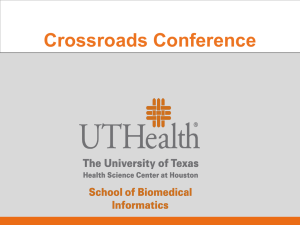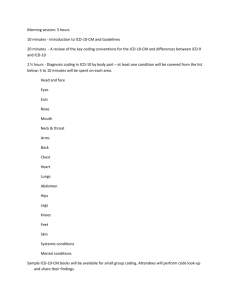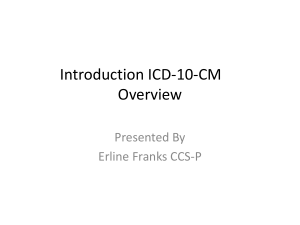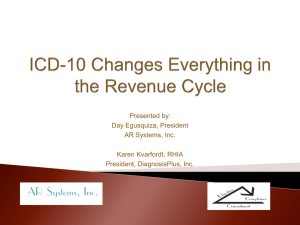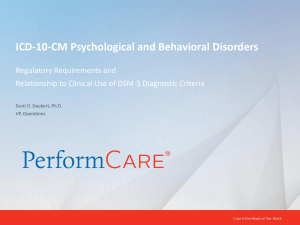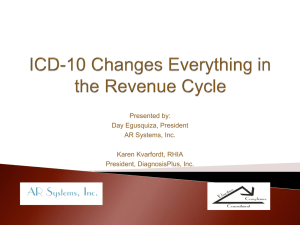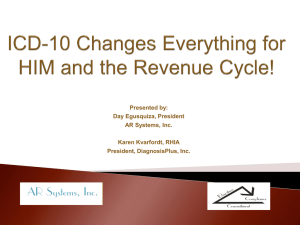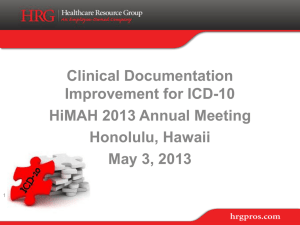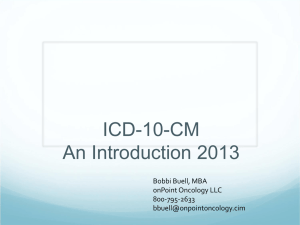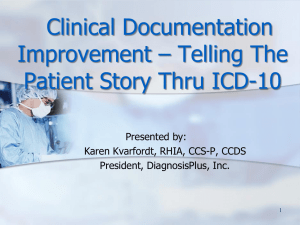Powerpoint Presentation part 2
advertisement
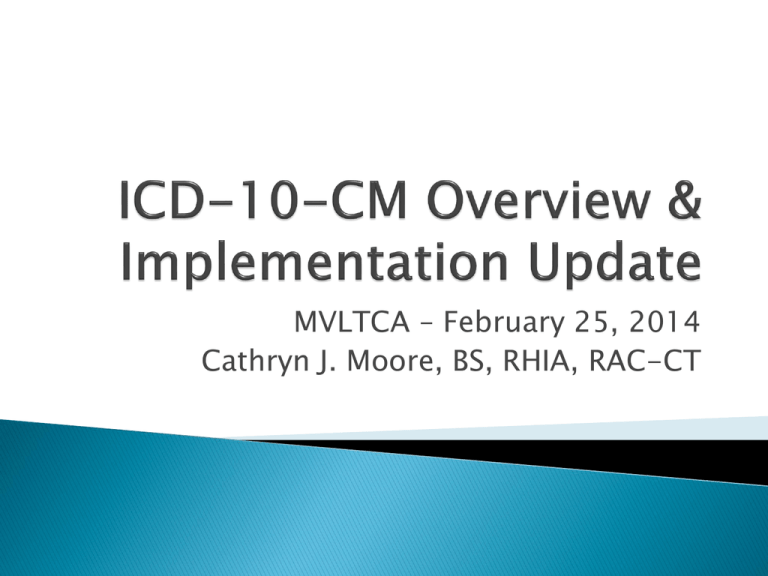
MVLTCA – February 25, 2014 Cathryn J. Moore, BS, RHIA, RAC-CT 1. Regulations which mandate implementation of ICD-10-CM 2. Updates that have occurred for conversion to the non-acute arena 3. Major differences from ICD-9 to ICD-10 4. Implementation Plan to facilitate a smooth transition to the new system Implementation Date: October 1, 2014 Final Rule: August 24, 2012 Available at http://www.cms.gov/Medicare/Coding/ICD10 /Statute_Regulations.html ICD-10 was created by the World Health Organization in1990 Since 2001, most of the world has adopted it U.S. modified it and added CM (Clinical Modification) Review more information at: http://www.who/int/classifications/icd/imple mentation/en/index.html 2014 ICD-10-CM is available at http://www.cdc.gov/nchs/icd/icd10cm.htm or http://www.cms.hhs.gov/ICD10 2014 ICD-10-CM Index to Diseases and Injuries 2014 ICD-10-CM Tabular List of Diseases and Injuries ◦ Instructional Notations 2014 Official Guidelines for Coding and Reporting 2014 Table of Drugs and Chemicals 2014 Neoplasm Table 2014 Index to External Causes 2014 Mapping ICD-9-CM to ICD-10-CM and ICD-10-CM to ICD-9-CM GEMs (General Equivalence Mappings) are a tool that can be used to convert data from ICD-9-CM to ICD-10-CM and vice versa. Mapping from 10 to 9 is referred to as backward mapping while 9 to 10 is referred to as forward mapping GEMs are a comprehensive translation dictionary that can be used to accurately and effectively translate any ICD-9-CM based data GEMs (General Equivalence Mappings) can be used by anyone who wants to convert coded data, including: All payers All providers Medical researchers Informatics professionals Coding professionals Software vendors Organizations Others who use coded data GEMs (General Equivalence Mappings) are not a substitute for learning how to use the ICD-10 codes. More information about GEMs and their use can be found on the CMS website at: http://www.cms.gov/Medicare/Coding/ICD10/i ndex.html Select from left side of web page to find most recent GEMs Medical Coding in U.S. health care settings will change from ICD-9-CM to ICD-10 Compliance date is firm (no grace period, no delays) ICD-10-CM diagnoses codes will be used by all providers in every health care setting ICD-10-PCS procedure codes will be used only for hospital claims for inpatient hospital procedures ICD-9-CM codes will not be accepted for services provided on or after 10-1-14 Check Your Understanding of Implementation Compliance Date ICD-10-CM codes will not be accepted for services prior to October 1, 2014 Providers must begin using ICD-10-CM codes to report diagnoses from all ambulatory and physician services on claims with dates of service on or after October 1, 2014, and for all diagnoses on claims for inpatient settings with dates of discharge that occur on or after October 1, 2014 ICD-10-PCS (procedure codes) must be used for all hospital claims for inpatient procedures on claims with dates of discharge that occur on or after 10-1-2014 New Classification system will provide better data needed to: Measure the quality, safety, and efficacy of care Reduce the need for attachments to explain the patient’s condition Design payment systems and process claims for reimbursement Conduct research, epidemiological studies, and clinical trials New Classification system will provide better data needed to: Set health policy Support operational and strategic planning Design health care delivery systems Monitor resource utilization Improve clinical, financial, and administrative performance Prevent and detect health care fraud and abuse Track public health and risks Overall number of codes is significantly increased from approximately 14,000 in ICD-9-CM to approximately 70,000 in ICD10-CM ICD-10-PCS codes increased from approximately 4,000 in ICD-9-CM to approximately 70,000 ICD-10 codes are longer and use more alpha characters Codes allow greater clinical detail and specificity in describing diagnoses and procedures Terminology and disease classification have been updated to be consistent with current clinical practice Last but not least is that system changes are required to accommodate the ICD-10 codes Numeric or (E or V) Numeric .. M X A 4 1 X 4 Category X 0 X 0 Etiology, anatomic site, manifestation 3–5 Characters 17 Alpha (Except U) M X X A S 0 X 2 Category 2-7 Numeric or Alpha . Additional Characters X 6 X 5 X x Etiology, anatomic site, severity A X Added 7th character for obstetrics, injuries, and external causes of injury 3–7 Characters 18 Cerebral Vascular Accident with Hemiplegia ICD-9-CM 438.20 ICD-10-CM I69.959 Fracture of the left hip ICD-9-CM V54.13 ICD-10-CM S72.002D Diabetes mellitus with retinopathy ICD-9-CM 250.50 362.01 ICD-10-CM E11.319 Combination codes for conditions and common symptoms or manifestations Combination codes for poisonings and external causes Added laterality Expanded codes (injury, diabetes, alcohol/substance abuse, postoperative complications) Injuries grouped by anatomical site rather than injury category I25.110 Atherosclerotic heart disease of native coronary artery with unstable angina pectoris E11.311 Type 2 diabetes mellitus with unspecified diabetic retinopathy with macular edema K50.012 Crohn’s disease of small intestine with intestinal obstruction N41.01 Acute prostatitis with hematuria T57.0X4A Toxic effect of arsenic and its compounds, assault C50.511 Malignant neoplasm of lower-outer quadrant of right female breast C50.512 Malignant neoplasm of lower-outer quadrant of left female breast C50.519 Malignant neoplasm of lower-outer quadrant of unspecified female breast C50.521 Malignancy neoplasm of lower-outer quadrant male breast S72.044G Nondisplaced fracture of base of neck of right femur, subsequent encounter for closed fracture with delayed healing I69.351 Sequelae of cerebral infarction, Hemiplegia and hemiparesis following cerebral infarction affecting right dominant side Z47.81 Encounter for orthopedic aftercare following surgical amputation Z48.21 Encounter for aftercare following heart transplant Addition of 7th character : Used in certain chapters to provide information about the characteristic of the encounter Must always be used in the 7th character position If a code has an applicable 7th character, the complete code must be reported with an appropriate 7th character value in order to be valid Character “x” is used as a 5 character placeholder in certain 6 character codes to allow for further expansion and to fill in other empty characters when a code that is less than 6 characters in length requires a 7th character T46.1x5A - Adverse effect of calcium channel blockers, initial encounter T15.02xD – Foreign body in cornea, left eye, subsequent encounter Excludes 1 – Indicates that the condition excluded should never be used with the code noted in the note (do not report both codes) Excludes 2 – Indicates that the condition excluded is not part of the condition represented by the code but a patient may have both conditions at the same time, in which case both codes may be assigned together (both codes can be used to capture both conditions) R22.2 Localized swelling, mass and lump, trunk Excludes 1: intra-abdominal or pelvic mass and lump (R19.0-) Excludes 2: breast mass and lump (N63) Inclusion of clinical concepts that do not exist in ICD-9-CM (e.g., underdosing, blood type, blood alcohol level) A number of codes have been significantly expanded (e.g., injuries, diabetes, substance abuse, postoperative complications) T45.526D – Underdosing of antithrombotic drugs, subsequent encounter Z67.40 – Type O blood, Rh positive Y90.6 – Blood alcohol level of 120-199 mg/100 ml E10.610 – Type 1 diabetes mellitus with diabetic neuropathic arthropathy F10.182 – Alcohol abuse with alcoholinduced sleep disorder T82.02xA – Displacement of heart valve prosthesis, initial encounter Injuries are grouped by anatomical site rather than by type of injury Category restructuring and code reorganization have occurred in a number of chapters, resulting in the classification of certain diseases and disorders that are different from ICD-9-CM Certain diseases have been reclassified to different chapters or sections in order to reflect current medical knowledge New code definitions (e.g., definition of acute myocardial infarction is now 4 weeks rather than 8 weeks) The V codes and E codes are incorporated into the main classification rather than separated into supplementary classifications as they were in ICD-9-CM The Uniform Hospital Discharge Data Set (UHDDS) provides definitions for primary and secondary diagnoses. Adapted to fit all non-inpatient settings (postacute) such as home healthcare, hospice, nursing facilities, and rehab facilities. In determining principal diagnosis/primary diagnosis, the coding conventions (instructional notes incorporated in the codes) take precedence over the Tabular and Alphabetic Index guidelines. The condition that caused the admission for services. That condition most relevant to the plan of care. That diagnosis which represents the most acute condition and will require the most intensive services. Co-Morbidities Additional Diagnoses used in coding guidelines. All conditions that coexist during the episode of care that may affect the plan of care or which developed subsequently and affect the treatment or care of the patient. Entered on the OASIS C (OASIS C-1) in the order by the degree of which they will impact the plan of care and the need for homecare services. Entered on the MDS only if active diagnoses and impact the plan of care. A diagnosis related to the prospective payment system; may involve manifestation coding. Medical record documentation must support the diagnosis reported on the OASIS-C and 485 and the MDS Assessment. The condition treated by the inpatient facility or by the physician in an outpatient setting relevant within the past 14 days. Any condition that is resolved and is no longer being treated. Appropriate for the OASIS C assessment but not the plan of care. Not appropriate for MDS assessment. A resident was admitted to the nursing facility following foot amputation due to diabetic peripheral vascular disease. PT and OT was ordered with the plan for the resident to return home. Staff is to change dressings and report any suture site breakdown to the physician. Other diagnoses include gastroparesis due to type 2 diabetes (receiving insulin), mitral valve regurgitation with aortic stenosis, inguinal hernia, generalized DJD and COPD. Assign Codes. A resident was admitted to the nursing facility following foot amputation due to diabetic peripheral vascular disease. PT and OT was ordered with the plan for the resident to return home. Staff is to change dressings and report any suture site breakdown to the physician. Other diagnoses include gastroparesis due to type 2 diabetes (receiving insulin), mitral valve regurgitation with aortic stenosis, inguinal hernia, generalized DJD and COPD. Assign Codes. Z47.81 Aftercare, following surgery (for) (on), amputation E11.51 Diabetes, diabetic (mellitus) (sugar) Type 2, with peripheral angiopathy E11.43 Diabetes, diabetic (mellitus) (sugar) Type 2, with gastroparesis I80.0 Regurgitation, mitral (valve) – see Insufficiency, mitral. Insufficiency, insufficient, mitral (valve), with aortic valve disease K40.90 Hernia, hernial (acquired) (recurrent), inguinal (direct) (external) (funicular) (indirect) (internal) (oblique) (scrotal) (sliding) M15.9 Disease, diseased, joint, degenerative—see Osteoarthritis. Osteoarthritis generalized J44.9 Disease, diseased, pulmonary, chronic, obstructive Z79.4 Z89.439 Long-term (current) (prophylactic) Absence (of) (organ or part) (complete or partial), foot (acquired) LTC resident returns home with orders for home health care..... E11.51 DM with PVD E11.43 DM with gastroparesis M15.9 OA (debility affecting ADL/IADL) J44.9 COPD (debility affecting ADL/IADL) I80.0 Mitral valve regurgitation with aortic stenosis: monitor signs/symptoms Z48.01 Change of surgical dressing: Z79.4 LT insulin use G54.6 Phantom Limb Syndrome, with pain **** must be documented by physician Patient has hypertension. He continues to experience elevated BP while taking BP medication. While assessing the patient, the nurse discovers he was taking his medication once daily instead of twice (as ordered) because of the cost of the drug. I10 Essential HTN T46.5x6D Underdosing of other antihypertensive drug, subsequent encounter Z59.8 Other problems related to housing and economic circumstances Learn about the structure, organization, and unique feature of ICD-10-CM Learn about the system impact and 5010 Identify areas of strength/weakness in medical terminology and medical record documentation Review and train to improve knowledge of medical terminology as needed Provide intensive coder training approximately 3-6 months prior to implementation Contact vendors to determine their state of readiness for implementation Provide additional training to refresh or expand knowledge in the biomedical sciences (anatomy, physiology, pathophysiology, pharmacology, and medical terminology) Communicate with all staff who will be impacted by the change to keep them updated and to make sure they understand their role in the transition Work with physicians to make sure they understand some of the changes that will need to be made in documentation to allow for greater specificity in coding with ICD-10 Three variables which you can control or influence. Human resources (coders, auditors, IT) IT systems (internal/external) Vendors **Training **Practice **Keep current with industry Additional Info ◦ http://www.cms.gov/Medicare/CodingICD10/index .html Medicare Fee for Service Provider Resources ◦ http://www.cms.gov/Medicare/Coding/ICD10/inde x.html Remember to check back regularly for updated implementation information!!! Frequently Asked Questions (FAQs) related to ICD-10 ◦ http://www.cms.gov/Medicare/Coding/ICD10/inde x.html ◦ Select Medicare Fee for Service Provider Resources link from the menu on left side of page, scroll down the page to “related links inside CMS” and select “ICD-10 FAQs” MLN Matters Additional Info ◦ http://www.cms.gov/Medicare/CodingICD10/index .html Medicare Fee for Service Provider Resources ◦ http://www.cms.gov/Medicare/Coding/ICD10/inde x.html AHIMA ICD-10 Website www.ahima.org/icd10 CMS Website http://cms.hss.gov/Medicare/Coding/ICD10/ index.html NCHS Website http://www.cdc.gov/nchs/icd/icd10cm.htm For coding in any medical institution, you will need more anatomy and physiology and related terminology background in order to help you navigate better through ICD-10. Everyone will need to take classes for ICD-10 which will be opening up. YOU ARE ONLY AS GOOD AS YOUR TOOLS…SO START COLLECTING!!
